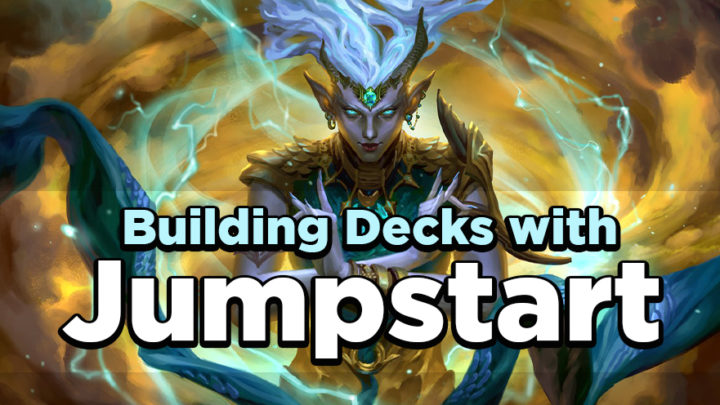By now, you’ve probably played with Jumpstart, and maybe you’ve found a few cards or packs in particular that resonated with you. Maybe you want to build a deck with cards you opened, but you’re not sure where to begin.
If you’re looking for some tips on how to transform your Jumpstart pack into a full-fledged deck, this article is for you. I’ll go over identifying your deck’s focus, how to find matching cards, and how to round out your deck with additional support cards.
Ready to create your deck? Let’s Jumpstart!
What’s Your Focus?
Let’s say you enjoyed three themes that you opened from your Jumpstart packs:
- Elves
- Well-Read
- Chandra
Let’s start with “Elves.”
You like the idea of having a bunch of cards all about elves. But what do you like about elves: gameplay or aesthetics (or both!)? Your answer will inform your deck-building choices and how you search for cards.
Here’s a good test for determining what’s important to you:

Would you be interested in including Elvish Fury in your deck because it fits your theme? Or would you be unhappy because the card doesn’t actually reward you for playing elf creatures?
Either way is OK, and you can build a great deck with each approach.
Next, let’s examine “Well-Read.” This theme is less straight-forward than “Elves” and you could interpret it in a few different ways.
While I was in college, I used to work at my school’s library. I’ve always been partial to Magic cards that illustrate libraries in some way, so if I were to build a “Well-Read” deck, I might choose cards like Curious Homunculus.

Someone else who builds a “Well-Read” deck may include lots of cards that draw cards – your deck is called a “library,” after all! Instead of Curious Homunculus, they might opt for a card like Library Larcenist.
If you enjoy drawing cards, there are many ways to build a deck that draws as many as possible. Use your favorite card search site to find cards with “draw” in the rules text. Keep in mind that some gameplay mechanics (such as cycling) also cause you to draw cards without explicitly using the word “draw,” so be sure to search for those cards, too.

Lastly, let’s talk about the “Chandra” theme.
As you did with Elves, it’s best to ask yourself what’s important to you about the Chandra theme. Do you want to just want to deal damage aggressively? You may find yourself pulling cards from the “Lightning” theme pack to support this goal. Or maybe you want to play Cathartic Reunion because it depicts an important moment in Chandra’s life. If so, that’s a great replacement for Thrill of Possibility in the “Chandra” pack.

You might even just like focusing on the word “Chandra.” There are enough Magic cards with “Chandra” in their names and flavor text to build an entire 100-card Commander deck!
Once you’ve chosen your focus, it’s time to fine-tune your deck.
Remember the Essentials
So, you’ve chosen the focus of your deck. Let’s say it’s spellcasting, based on the Jumpstart theme pack. You put a bunch of instants, sorceries, and lands together to make a deck. But there are also cards that aren’t instants or sorceries that synergize with spellslinging and can help you win more efficiently. You might also need some additional cards to help protect your strategy, or to answer opposing problem cards.
For gameplay-related themes, aim for a balance between cards that are on-theme versus cards rewarding you for it. While the exact ratio can differ in each deck, I tend to follow this general guideline:
At least 20% of cards are on-theme
10% of cards reward you for playing the theme
40% of cards are land cards or mana sources

Now, let’s say your opponent has a Blessed Sanctuary. This card can be a problem for your spellcasting deck, which tends to deal a lot of noncombat damage. But if you include a card like Meteor Golem in your deck, you can deal with Blessed Sanctuary and other problem cards you might encounter. An answer card can help you stay in the game, even if it doesn’t match your theme.
You might also find yourself in a rut if your spellcasting deck runs out of fuel. You might find up with no spells in your hand or worse – no creatures on the battlefield! A card like Reforge the Soul can help get the ball rolling again.
Even when your deck is running smoothly, things might be going even better for your opponent. That’s why it’s important to include removal – cards that deal damage to creatures or destroy or exile permanents. These range from efficient spells that deal with a single target to bigger spells that can answer a lot of cards at once.
Luckily, a red spellcasting deck often usually has many ways to remove creatures through direct damage. However, it especially helps to ensure you have a board wipe. Consider adding cards like Volcanic Vision and Blasphemous Act; while the latter destroys your own creatures, it may be necessary if your opponents’ creatures are even bigger. In fact, one of the spellcasting theme packs already includes Immolating Gyre — a great removal option!

Jumpstart Deckbuilding
Hopefully, these tips have helped set you in a direction to build decks with your favorite themes. I know I’m personally excited by the Lightning theme and casting Ball Lightning.
Once you’ve created your deck, you can fine-tune it using other deck-building strategies. (Check out my mana curve article here!)
If you have other questions about building decks with your Jumpstart cards, tweet at me at @bradleyrose.
Until next time, stay true to your theme!

Bradley is a co-host of a weekly Magic: The Gathering design podcast, Beacon of Creation. He was among the Top 101 contestants in Wizards of the Coast’s Great Designer Search 2. He enjoys crafting custom Magic product experiences, like Archfrenemies, and building Commander decks with creative constraints.

